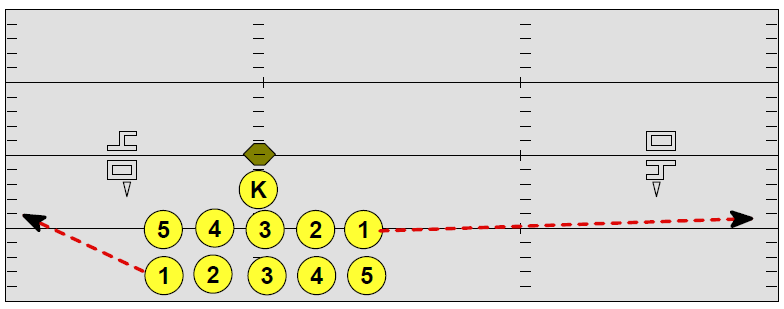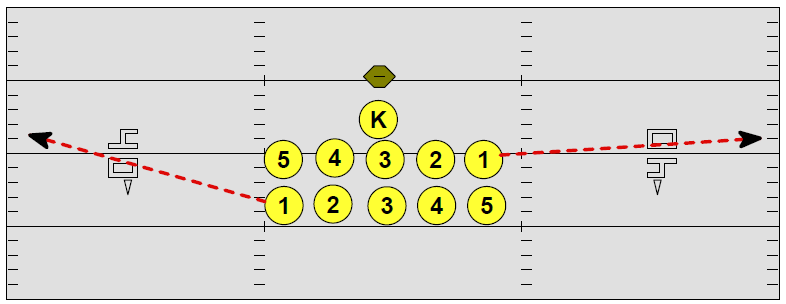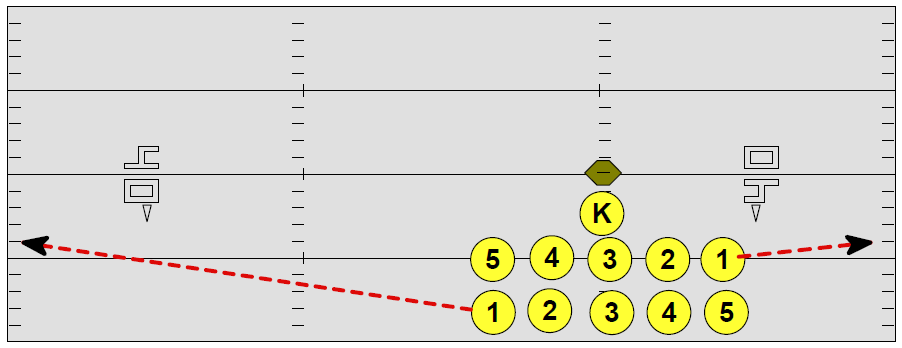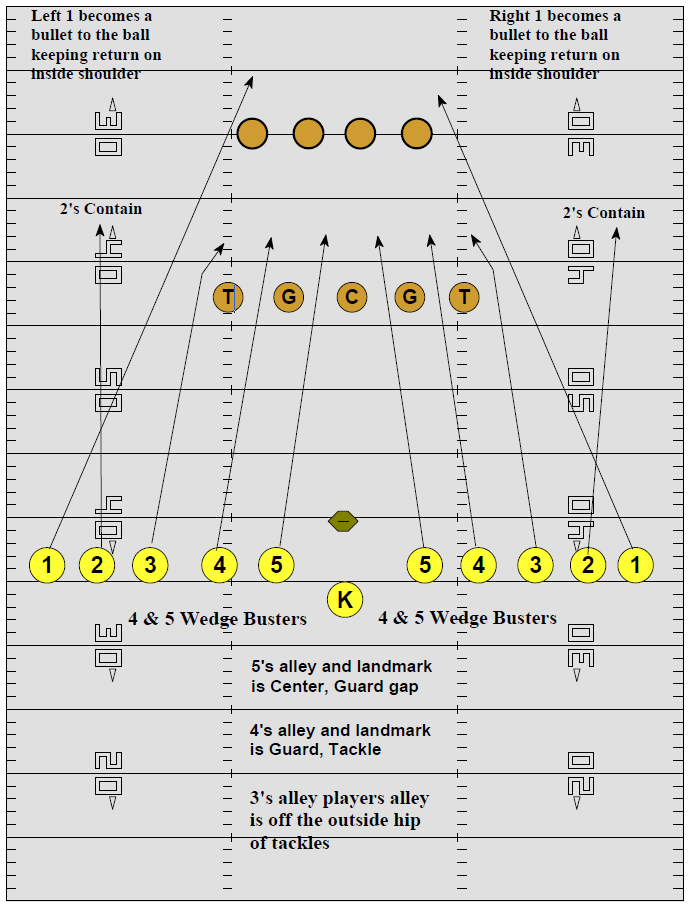Setting The Huddle For Your Kickoff Unit
Attacking The Middle Wedge Return
HUDDLE
We will always meet on the sideline (fifty-yard line) to allow the coach to count players and give them reminders. The coach will make the kickoff alignment call (right hash, middle, left hash) and provide a preliminary directional call, but the kicker will give the final call once the referee has readied the ball for play.
A choirboy type huddle will be formed on the thirty-five yard-line (five yards behind the tee). The players will remain in the huddle until the ball is signaled “ready for play” and the kicker has returned to the huddle. The kicker will then make the kickoff call; say ready and “hit”. The players will clap as they say, “hit”, then sprint to their alignments. Remember, the ball must be kicked within twenty-five seconds of the ball being signaled “ready for play”.
We will always huddle, and be in the huddle as the ball is signaled “ready for play” by the referee. The kicker will stand next to the tee, with the kickoff team huddled five yards back; on the thirty-five (high school rules) or the thirty (college rules). Once the official hands the ball to the kicker, they will place it on the ground next to the tee. The kicker will then return to the huddle and make the call, identifying the kick, and coverage scheme. They will then the break the huddle, and approach the ball to tee-it-up. If the kick return team does not adjust their alignment to cover up the players in the huddle, we will evaluate an onside kick from the huddle alignment.
This is a very important process. Teams that huddle, but break the huddle before the officials signal the ball “ready for play” create NO stress or requirement for adjustments by the return team. The reason is the ball cannot be put into play until the referee signals “ready for play”. Therefore, the kick return team does not need to adjust their alignment because the kickoff team is in their spread formation when the ball is signaled “ready for play”; i.e., the kickoff team can only kick the ball once the referee signals “ready for play”. However, when a team is huddled when the ball is ready for play, it forces the return team to adjust their return alignment (compress it) in case of an onside kick, or a possible kick from the huddle formation. If the return team does not adjust, they can very easily be out-numbered with an easy recovery for the kickoff team.
Setting The Huddle For Your Kickoff Unit
Left Hash

Middle Kick

This is a very important process. Teams that huddle, but break the huddle before the officials signal the ball “ready for play” create NO stress or requirement for adjustments by the return team. The reason is the ball cannot be put into play until the referee signals “ready for play”. Therefore, the kick return team does not need to adjust their alignment because the kickoff team is in their spread formation when the ball is signaled “ready for play”; i.e., the kickoff team can only kick the ball once the referee signals “ready for play”. However, when a team is huddled when the ball is ready for play, it forces the return team to adjust their return alignment (compress it) in case of an onside kick, or a possible kick from the huddle formation. If the return team does not adjust, they can very easily be out-numbered with an easy recovery for the kickoff team.
Right Hash

We designed a coverage scheme that has “Bullets”,Wedge Buster’s, “Alleys” and “Contain”. This creates efficiency in preparing our back-ups. We can get three back-ups for each position because a bullet is a bullet regardless of where they align. Therefore we do not need to have two complete Kickoff Units because the positions are interchangeable. As such, when injuries occur the back-ups have gotten plenty of repetitions, and there is no confusion in their mind as to their coverage responsibilities. In addition, this approach to coverage creates two distinct waves of defenders, which is discussed in greater detail below.
The players will utilize a “form start” and time their approach with the kicker. We align only five yards from the ball because we want immediate acceleration. This allows the coverage defenders to be at full speed as the ball is kicked. The different level of defenders is created based upon the coverage responsibilities and the techniques that the Bullets, Wedge Buster’s and Alleys use in coverage; i.e., the distance they sprint before they converge on the football.
We will directional kick from either hash, as well as kicking off from the middle of the field. The sideline coach will designate the kickoff alignment when the Kickoff Team huddles along the sideline. This determination is based upon the scouting report and the type of kicks to be used against the particular opponent. When the kicker breaks the huddle on the field, after the referee has signaled the ball “ready for play”, the Kickoff Team will sprint to their appropriate alignment.
The Kickoff Team consists of:

About the Author of this post:
Jerry Campbell has over 30 years of high school and college coaching experience. He has experience as a head coach, offensive coordinator, and various position coaches. He has written numerous football coaching articles in various publications, is the author of over 30 books on coaching football, and has produced 12 coaching video series. Additionally, he is a nationally sought after speaker on the coaching clinic circuit.